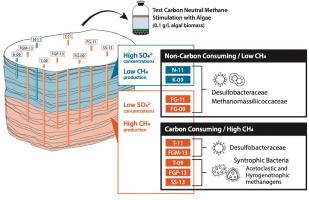International Journal of Coal Geology ( IF 5.6 ) Pub Date : 2021-09-29 , DOI: 10.1016/j.coal.2021.103860 H.J. Smith 1, 2 , H.D. Schweitzer 1, 2 , E.P. Barnhart 3 , W. Orem 4 , R. Gerlach 1, 5 , M.W. Fields 1, 2

|
Biogenic methane is estimated to account for one-fifth of the natural gas worldwide and there is great interest in controlling methane from different sources. Biogenic coalbed methane (CBM) production relies on syntrophic associations between fermentative bacteria and methanogenic archaea to anaerobically degrade recalcitrant coal and produce methanogenic substrates. However, very little is known about how differences in geochemistry, hydrology, and microbial community composition influence subsurface carbon utilization and CBM production. The addition of an amendment consisting of microalgal biomass has previously been shown to increase CBM production while providing the possibility of a closed-loop fossil system where waste (production water) is used to grow algae to ultimately produce energy (methane). However, the efficiency of enhancing CBM production under different redox conditions remains unresolved. In this study, we focused on the U.S. Geological Survey's Birney test site (Montana, USA) that has nine wells vertically accessing four coal seams with varying geochemistry (low and high sulfate (SO42−)) and methane production rates. We used organic matter (OM) in the form of algal biomass to discern the effect of this amendment on OM degradation and microbially enhanced CBM production potential under different geochemical constraints. We tracked changes in community composition, OM composition, organic carbon (OC) concentration, methane production, and nutrients in batch systems over six months. Methane production was detected only in microcosms from low SO42− wells (168 to 800 μg methane per gram of coal). The OC consumption varied across time for all wells and the variation was greatest for the low SO42− wells. Different groups of syntrophic bacteria were associated with net‑carbon consuming microcosms, and specifically Syntrophorhabdus was identified with several different statistical methods as a potentially important coal degrader. Results from this study provide insight into potential coal-degraders, the compositional changes in some of the different OM fractions, and trends in carbon consumption related to methane production across coal seams along the vertical SO42− gradient.
中文翻译:

藻类改良剂对美国粉河盆地不同硫酸盐浓度下煤微生物转化为甲烷的影响
据估计,生物甲烷占全球天然气的五分之一,人们对控制不同来源的甲烷非常感兴趣。生物煤层气 (CBM) 生产依赖于发酵细菌和产甲烷古菌之间的同养关联,以厌氧降解顽固煤并产生产甲烷底物。然而,人们对地球化学、水文和微生物群落组成的差异如何影响地下碳利用和煤层气生产知之甚少。添加由微藻生物质组成的改良剂先前已被证明可以增加 CBM 产量,同时提供闭环化石系统的可能性,其中废物(生产水)用于种植藻类以最终产生能量(甲烷)。然而,在不同氧化还原条件下提高煤层气产量的效率仍未解决。在这项研究中,我们重点关注美国地质调查局的伯尼试验场(美国蒙大拿州),该试验场有 9 口井,可垂直进入具有不同地球化学性质(低和高硫酸盐 (SO4 2− )) 和甲烷产率。我们使用藻类生物质形式的有机物质 (OM) 来辨别这种修正对 OM 降解的影响,以及在不同地球化学约束下微生物增强 CBM 生产潜力的影响。我们跟踪了六个月内批量系统中群落组成、有机质组成、有机碳 (OC) 浓度、甲烷产量和养分的变化。甲烷产量仅在来自低 SO 4 2−井(每克煤 168 至 800 μg 甲烷)的微观世界中检测到。所有井的 OC 消耗量随时间变化,低 SO 4 2-井的变化最大。不同群体的共养细菌与净碳消耗微观世界有关,特别是Syntrophorhabdus被鉴定为几种不同的统计方法作为潜在的重要煤炭降解剂。这项研究的结果提供了对潜在煤降解物、一些不同 OM 部分的组成变化以及与沿垂直 SO 4 2-梯度跨煤层甲烷生产相关的碳消耗趋势的深入了解。











































 京公网安备 11010802027423号
京公网安备 11010802027423号